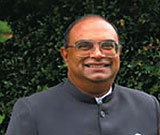 |
Chennai-born Sabapathy is Queen’s rep in West Midlands |
Chennai-born financial analyst and educationist Paul Chandrasekharan Sabapathy has become the first non-white to be accorded a rare British honour that makes him Queen Elizabeth’s personal representative in the West Midlands.
“The Queen has been pleased to appoint Paul Sabapathy Esq. CBE as Her Majesty’s Lord-Lieutenant for the County of the West Midlands following the retirement of Sir Robert Taylor KCVO,” a statement issued from 10 Downing Street said.
“Lord-Lieutenants are the monarch’s representatives in their lieutenancy. It is their foremost duty to uphold the dignity of the Crown, and in so doing they seek to promote a spirit of co-operation and good atmosphere by the time they give to voluntary and benevolent organisations and by the interest they take in the business and social life of their counties,” an official said explaining the appointment.
The office dates from the reign of Henry VIII (1509-1547) in the Tudor days, and the Lord-Lieutenant was originally responsible for the maintenance of order and for local defence.
The current responsibilities include all aspects of visits by members of the Royal Family, escorting Royal Visitors, presentation of awards and medals on behalf of the Queen, representing the Queen at a variety of events, chairmanship of the advisory committee that recommends the appointment of magistrates to the Lord Chancellor, liaison with local units of the armed forces, and advising on honours nominations.
The West Midlands covers Birmingham, Britain’s second largest city, Coventry, Solihull, Wolverhampton, Walsall, Sandwell, and Dudley, with a total population of about 3.5 million. There have been only two previous holders of this office since 1974, when the county was established. Sabapathy is currently the chairman and pro-chancellor of the University of Central England, Birmingham, the first non-white to hold the post.
Born in Chennai, Sabapathy moved to Britain in 1964, when he was 21.
|
|
|
|
|
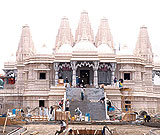
|
$40 million temple ready to open its doors
|
A Hindu temple in Toronto that cost $40 million to built, one of the largest initiative of its kind ever undertaken by the Indian Canadian community, is all set to open its gates to the general public. The Swaminarayan Mandir has been completed in 18 months without government funding by craftsmen who used 24,000 hunks of Italian marble and Turkish limestone.
It is also the first Hindu temple in Canada to be built according to ancient Vedic principles. Most of the temple was carved using hammer and chisel by close to 2,000 craftsmen, 100 of them flown from India. The local Hindu community offered up about 400 devoted volunteers and footed the bill for much of the temple. “It gives me a sense of pride, a reputation for first-generation Indian Canadians that we are integral members of this country,” said activity co-ordinator Aarti Patel. “In addition to Canadian winters, another major hurdle was convincing Toronto city officials that the temple, a completely steel-free structure, was sound engineering,” said Naren Sachdev, project manager of construction.
Virtually every inch of the place is embellished with carved deities—cavorting horses, peacocks, elephants, lotus flowers and vines—each representing different Hindu virtues.
|
|
|
|
|

|
16,000 Indians seek to make Australia home
|
As many as 15,865 Indians sought permanent residence in Australia under the skilled migration programme in 2006-2007, making them the second largest group in the category after Britons.
Partha Mukherjee, an alumnus of the Indian Institute of Technology, Kharagpur, and Indian Institute of Management, Ahmedabad, came to Australia three years ago with his wife under the skilled migrant programme.
He says, “I had position and wealth in Mumbai, but chose to migrate to Sydney for the quality of life. I wanted a balanced work and family life.” However, his three children are doing their schooling and college in India. He says, “I feel if you really want to achieve high, India and the US offer more opportunities for success.”
India ranks second amongst the top five countries of origin for skilled stream entrants. Britain leads the way with 24,800 skilled migrants coming Down Under, followed by India (15,865), China (14,688), South Africa (4,293) and Malaysia (3,838).
Despite steady economic growth for the last decade or so, Australia is facing a serious skills shortage with the ageing workforce retiring in greater numbers.
The top occupation for skilled stream entrants is accountancy (10,688), followed by computing professionals (4,044) and registered nurses (2,088). Other top professions included mechanical engineers, civil engineers, marketing specialists and general managers.
|
|
 |
Indo-Trinidadian community celebrates Rakhi
|
The Indo-Trinidadian community in Port-of-Spain celebrated Rakshabandhan with fervour and joy. On this day, sisters tie a rakhi (coloured thread) on the wrist of their brothers for protection and to invoke the blessings of God.
The festival has its origins in India and was brought to these shores by Indian labourers more than a century ago. Sisters were seen visiting their brothers and paying obeisance at Hindu temples in Port-of-Spain.
Over the years the Hindu festival has enveloped the national community and non-Hindu residents also take part in this auspicious occasion, online edition of Trinidad Express reported. In fact, the famous Hindi song Bhaiya Mere from the 1958 film Chhote Behen has become an anthem for the festival.
The Indian community is mainly descendants of indentured Indian labourers who came to work in the sugar plantations in this country over a hundred years ago. There are around 520,000 Indo-Trinidadians in a population of a million.
|
|
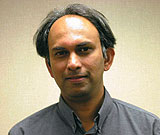
|
Indian-Americans develop paper-thin battery
|
A team of six Indian-American researchers has developed a new energy-storage device which, besides being paper-thin, can use human blood or sweat to power itself.
The team, led by noted nanotechnologist Pulickel Ajayan of Rensselaer Polytechnic Institute (RPI), has developed a battery, which could easily be mistaken for a simple sheet of black paper. Besides, it is lightweight, ultra thin, completely flexible, and geared towards meeting trickiest designs and energy requirements, the INDOlink web site said. “The semblance to paper is no accident: more than 90 per cent of the device is made up of cellulose, the same plant cells used in newsprint, loose leaf and lunch bags,” writer Francis Assisi said.
The device can be rolled, twisted, folded, or cut into any number of shapes with no loss of mechanical integrity or efficiency. It even as the ability to function in temperatures up to 300 degrees Fahrenheit and down to 100 below zero, and can be printed like a paper. “It’s essentially a regular piece of paper, but it’s made in a very intelligent way,” Robert Linhardt, co-author of the paper said.
Along with use in small handheld electronics, it is billed as ideal for use in automobiles, aircraft, and even boats. Besides Ajayan, the co-authors of the paper include Dr Nalamasu, Victor Pushparaj, Shaijumon Manikoth, A. Shavani Kumar and Saravanababu Murugesan, each of whom graduated from prestigious Indian institutes like the IISc, IIT etc.
|
|
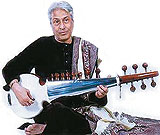 |
Amjad Ali Khan wows US business |
|
Sarod maestro Amjad Ali Khan and his sons Ayaan and Amaan enthralled captains of Indian and US industry gathered for the Global India Summit with a virtuoso performance.
A cultural evening organised by the US India Business Council, an advocacy organisation of US companies investing in India and global Indian companies, to mark its 32nd anniversary began with Khan dilating on the “cultural ties that bind” India.
The Khans, who were accompanied on the tabla by Sandeep Das, started with a tribute to Gandhi with a rendering of his favourite hymns Vaishnav Janato and Ram Dhun. Each item was greeted by a round of prolonged applause but what brought the house down was a rendering of Raga Malkaus, traditional pentatonic night raga. It was the kind of music, Amjad Ali said, that he could play by himself for the whole night.
Then as the music reached a crescendo, the audience gave a standing ovation to the maestro and his team.
Sarod, as Amjad Ali explained, is an Indian classical music instrument which originates from the Senya rebab, an Indo-Persian instrument played in India in the 16th-19th centuries.
|
|
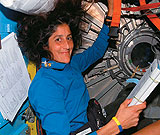 |
Sunita to visit India next month, go to her ancestral village |
Indian-American astronaut Sunita Williams, who set a record for the longest stay in space by a woman, will visit India in September and tour her ancestral village in Gujarat’s Mehsana district.
During her brief visit with her father, Sunita will also visit her ancestral village Jhulasan in Mehsana district of North Gujarat.
Though the exact itinerary of Williams’ visit is yet to be worked out, she plans to visit some scientific institutions in Hyderabad and Chennai.
Sunita recently took part in the annual India Day Parade held in New York as the guest of honour, along with Bollywood beauty Priyanka Chopra, who took part as grand marshall. The parade to celebrate 60 years of India’s independence was organised by the Federation of Indian Associations. |
|